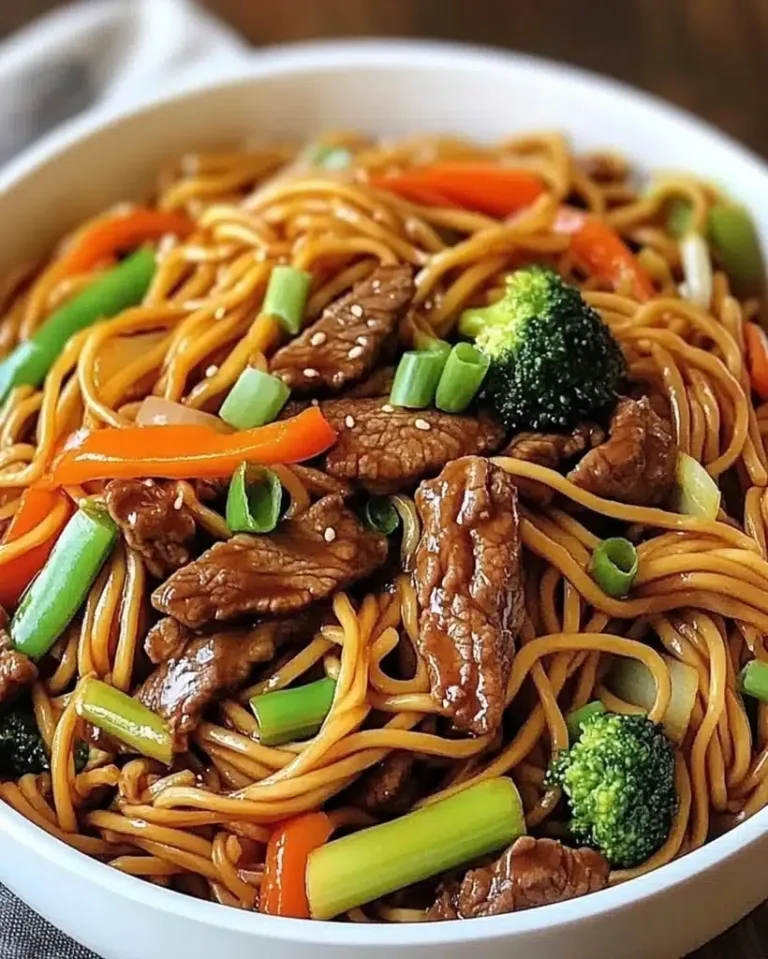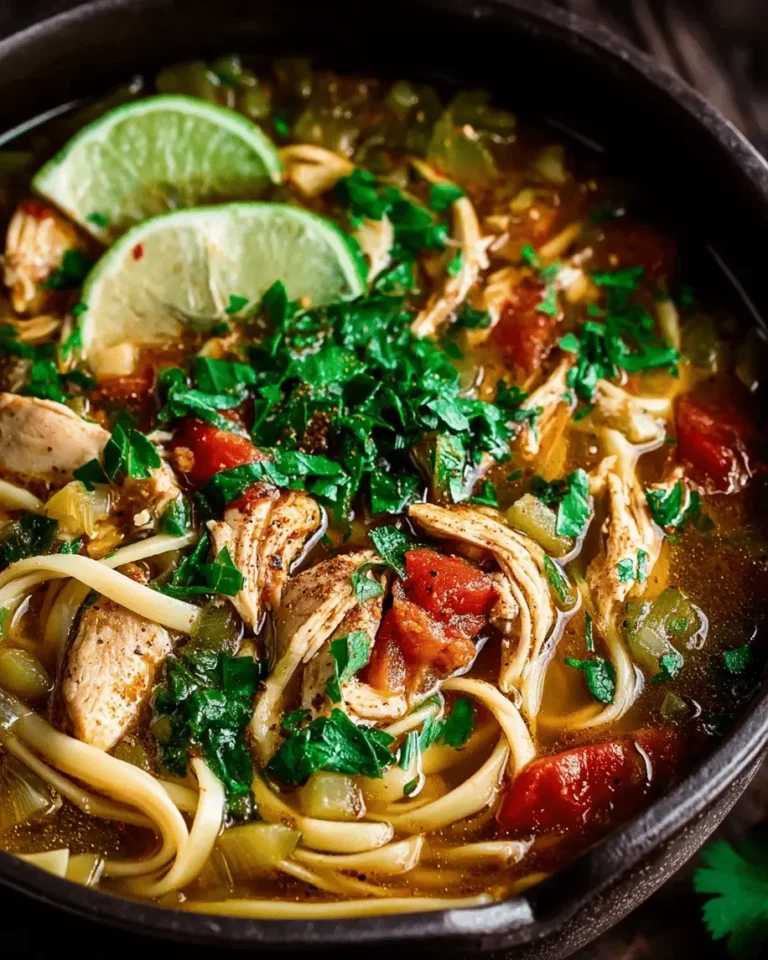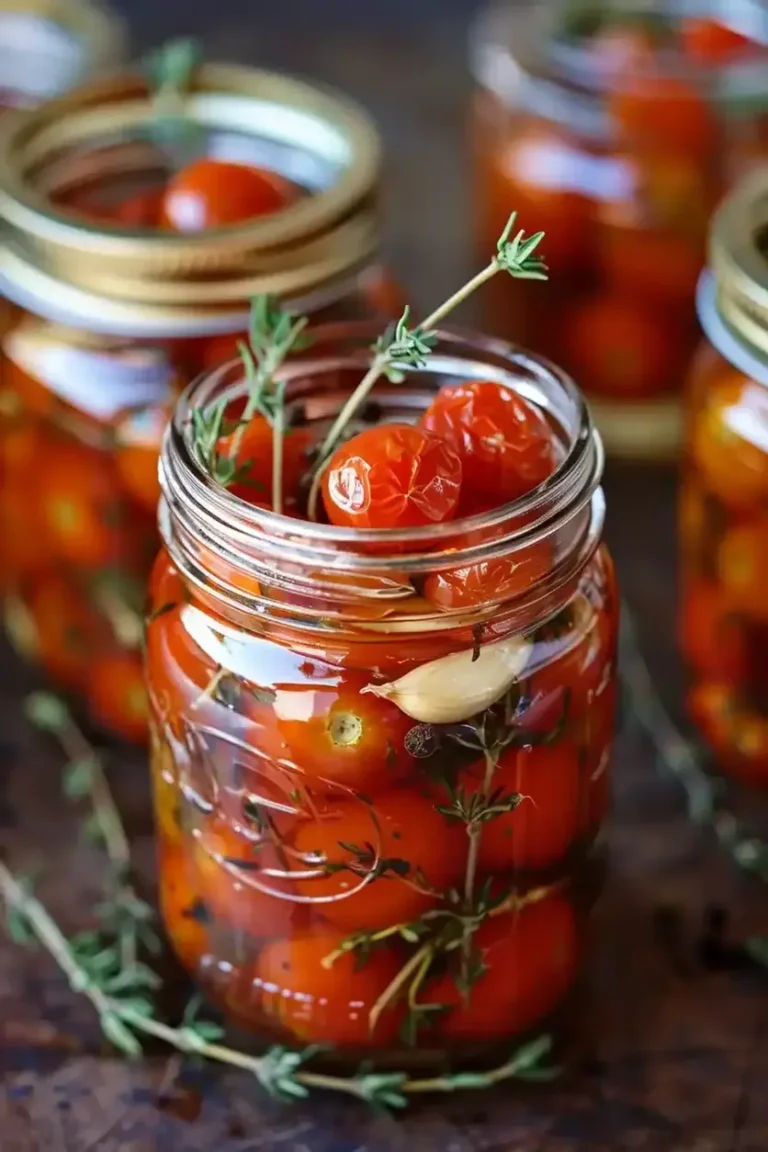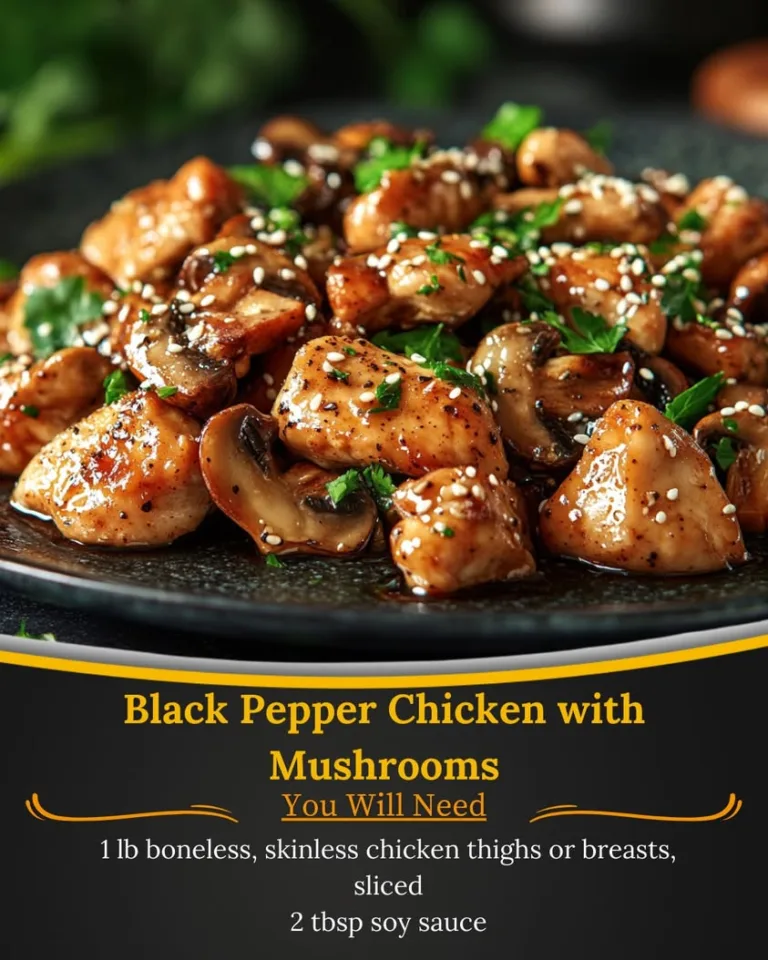Easy Slow-Cooked Beef in Onion Sauce – Ultimate Comfort Food
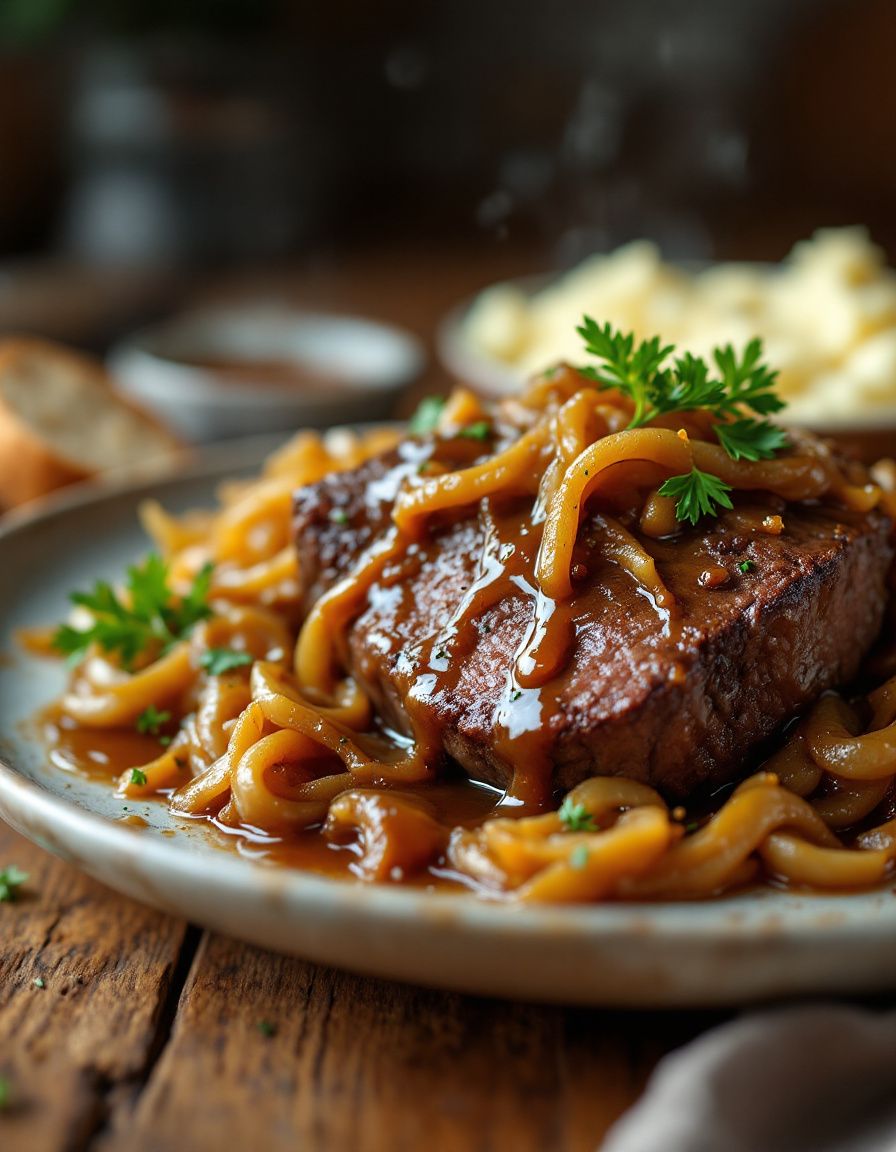
Slow-Cooked Beef in Onion Sauce – Melt-in-Your-Mouth Comfort Food!
Slow-Cooked Beef in Onion Sauce is the ultimate comfort food that brings warmth to any table. Imagine sinking your fork into tender chunks of beef, bathed in a rich, savory onion sauce that envelops each bite with layers of flavor. This dish is not just a meal; it’s an experience that invites you to slow down and savor the moment. Slow-cooking allows the beef to absorb all the aromatic goodness, transforming it into a melt-in-your-mouth treat that’s perfect for family dinners or cozy gatherings.
The secret behind this dish lies in its simplicity and the depth of flavor achieved through slow cooking. As the beef simmers, the onions caramelize, releasing their natural sweetness and infusing the sauce with a delightful richness. Each bite is complemented by herbs that elevate the flavor profile and make your taste buds dance with joy. Whether served over fluffy mashed potatoes, hearty rice, or buttery noodles, this dish is sure to impress and satisfy even the pickiest eaters.
Quick Recipe Highlights
- Flavor Profile: The dish boasts a rich umami flavor, beautifully balanced with the sweetness of caramelized onions and a hint of herbs.
- Texture: Each piece of beef becomes fork-tender, while the sauce maintains a smooth, silky consistency, creating a perfect mouthfeel.
- Aroma: As it cooks, the aroma of savory beef melded with sweet onions and spices fills your kitchen, creating an inviting atmosphere.
- Visual Appeal: The deep brown sauce with tender chunks of beef and glistening onions creates a visually stunning dish.
- Skill Level Needed: Perfect for beginners and seasoned cooks alike, this recipe requires minimal skill while delivering impressive results.
- Special Equipment: A slow cooker is essential for this recipe to develop the deep flavors through low, slow cooking.
Recipe Overview
- Difficulty Level: This recipe is classified as easy, perfect for cooks of all experience levels. The slow cooker does most of the work, allowing you to focus on enjoying the delicious outcome.
- Category: This dish fits seamlessly into the main course category, making it a dine-in favorite for hearty suppers and gatherings.
- Cuisine: Taking inspiration from classic comfort food traditions, this dish showcases the versatility of beef in home-cooked meals.
- Cost: The ingredients are budget-friendly, making it an economical choice for family dinners without sacrificing flavor.
- Season: Ideal for all seasons, this comforting dish particularly shines during colder months when a hearty meal is most welcome.
- Occasion: Perfect for family dinners, meal preps, gatherings, or whenever you desire a taste of home cooking.
Why You’ll Love This Recipe
The taste and texture of Slow-Cooked Beef in Onion Sauce are simply irresistible. The rich, savory flavor combined with the sweet, caramelized onions creates a symphony of tastes that dance on your palate. The beef’s tender texture, achieved through long, slow cooking, makes for a pleasurable eating experience, encouraging you to indulge in every last bite. It’s comfort food at its finest, serving to nourish not just the body but the soul.
Convenience is an incredible aspect of this recipe. With only 15 minutes of prep time, you can toss the ingredients into a slow cooker and let it do the magic while you go about your day. The freedom that comes with a slow cooker allows for multitasking, giving you more time to attend to other tasks without compromising on the quality of your meal. It’s a lifesaver for busy families seeking wholesome dinners after long days.
This dish doesn’t just tantalize your taste buds; it also offers nutritional advantages. Beef is a great source of protein, iron, and essential vitamins, making this meal both satisfying and nourishing. The addition of onions adds fiber and vitamins, contributing to a well-rounded dish that supports your health while catering to your cravings.
When it comes to social value, Slow-Cooked Beef in Onion Sauce is a fantastic dish for entertaining. Picture a gathering of friends and family, seated around the table, sharing laughter and stories while enjoying this hearty meal. It serves as a perfect centerpiece that sparks conversation and brings people together, making any occasion more memorable.
Cost-effectiveness is yet another reason to fall in love with this recipe. Using affordable cuts of beef that benefit from slow cooking, this dish stretches your dollar while providing a delicious, filling meal. Ideal for meal-prepping or feeding a crowd, it ensures that you can enjoy high-quality comfort food without breaking the bank.
Historical Background and Cultural Significance
The origin of slow-cooked meat dishes dates back centuries, evolving as a practical way to tenderize tougher cuts of meat. In various cultures, this method has been embraced for its efficiency and the robust flavors it produces, often resonating with traditional home-cooking that spans generations. Rural families would use whatever they had on hand, leading to the unique flavor profiles that are celebrated today.
Culturally, beef in onion sauce has roots in many food traditions. The use of onions not only enhances flavor but is also a symbol of sustenance and comfort. Across the globe, you will find variations of this dish, each telling its own story and reflecting local tastes, further enriching the culinary landscape.
Over the decades, the recipe has evolved, transitioning from simple slow-cooked meals often utilizing leftover meats, to elegantly presented dishes in fine dining. Its accessibility has allowed it to remain a staple in home-cooked meals while adapting to modern culinary trends, ensuring it stays relevant.
Regional variations abound, from the classic French onion beef stew to Italian Braciole, showcasing the adaptability of this hearty dish. While the core recipe remains the same, local ingredients and spices lend each version its unique flair, celebrating diverse cooking traditions around the world.
Ingredient Deep Dive
Beef, the star ingredient in this dish, has a rich cultural history dating back thousands of years. It has been a primary source of sustenance in many civilizations. Nutritionally, beef is packed with protein, iron, and essential nutrients like B-vitamins, which are crucial for energy levels. When selecting beef for slow cooking, look for tough cuts like chuck roast or brisket, as they become tender when slow-cooked. Store uncooked beef in the refrigerator for up to three days or freeze it for extended life.
Onions play a critical role in this recipe, offering not only flavor but also numerous health benefits. They are rich in antioxidants and have anti-inflammatory properties. When selecting onions, look for firm, smooth-skinned varieties, free from blemishes. Store them in a cool, dry place away from light to maximize freshness. For substitutes, shallots or green onions can provide similar flavors, although they may alter the overall dish’s sweetness.
Herbs and spices bring this dish to life, adding aromatics that enhance the flavor profile. Often, dried herbs like thyme and bay leaves are used for their concentrated flavor. When selecting herbs, fresh is typically preferred for a brighter taste, but dried works wonderfully in slow cooking. Store dried herbs away from heat and moisture, and use within six months for maximum potency. For substitutions, you can mix in herbs like rosemary or Italian seasoning for a different flavor experience.
Beef broth or stock is essential for a deeply flavored sauce. It enhances the overall richness and complements the beef perfectly. Choose low-sodium varieties if you’re watching salt intake. Store opened broth in the refrigerator for up to a week or freeze for longer storage. When in a pinch, water can work as a substitute, but it may dilute flavors slightly.
Common Mistakes to Avoid
- Skipping the browning step: Not browning the meat before slow cooking can result in a less robust flavor. Browning helps develop a richer taste.
- Overcrowding the slow cooker: Filling your slow cooker too full can lead to uneven cooking. Leave space for heat circulation to ensure even cooking.
- Using high heat: Cooking on high can result in tough meat. Low and slow is the key to achieving that tender, melt-in-your-mouth vibe.
- Not seasoning adequately: Underestimating the need for seasoning can leave the dish bland. Taste and adjust the seasoning throughout the cooking process for best results.
- Skipping the rest phase: Not letting the beef rest after cooking can lead to loss of juices. Allow the dish to sit for a few minutes before serving.
- Not adjusting liquid levels: Adding too little or too much liquid can affect the sauce’s consistency. Monitor the liquid and adjust as needed during cooking.
- Using low-quality beef: Affordable cuts can be great, but make sure they are still of decent quality for the best results in flavor and texture.
- Neglecting to skim fat: A greasy sauce can ruin the dish’s visual appeal and flavor. Skim off excess fat before serving for a cleaner presentation.
- Failing to adapt to your slow cooker: Different slow cookers have different heat levels. Familiarize yourself with your appliance and adjust cooking times if necessary.
- Not adding vegetables: Some recipes omit vegetables entirely, but adding carrots or celery can enhance both flavor and nutrition.
Essential Techniques
Browning the meat is one of the most crucial techniques for this recipe. This step locks in flavor and creates a beautiful sear on the outside of the beef, which ultimately enhances the dish’s depth. To master this, heat your pan properly and ensure not to overcrowd it—this will help achieve a perfect brown crust.
Deglazing the pan after browning is another key technique. After cooking the beef, adding a splash of broth or wine to the hot pan helps lift the flavorful bits stuck to the bottom, incorporating them back into the sauce. This step adds layers of flavor and richness, elevating your dish considerably.
Monitoring liquid levels throughout the cooking process is imperative. Too little liquid can lead to dry meat, while too much can create a watery sauce. Pay attention to your slow cooker’s performance and check if you need to add more broth or if it’s cooking too rapidly.
Letting the dish rest after cooking can make a world of difference. This allows the juices to redistribute, ensuring that the beef remains moist and tender upon serving. Take this time to prepare any sides or garnishes, enhancing your overall presentation.
Pro Tips for Perfect Slow-Cooked Beef in Onion Sauce
Select the right cut of beef; chuck roast works exceptionally well due to its marbling, which breaks down beautifully in slow cooking.
Always brown the meat before adding it to the slow cooker for enhanced flavor.
Adjust your cooking liquid based on personal preference—add more broth for a saucier dish or less for a thicker sauce.
Incorporate vegetables like carrots and potatoes for extra nutrition and flavor.
Use freshly chopped herbs during the last hour of cooking for a fresher herb taste.
Serve with a side of crusty bread to soak up the delicious sauce.
Make this dish a day ahead for even better flavors; the tastes meld beautifully as it rests overnight.
Top the finished dish with a sprinkle of fresh parsley for a bright color contrast and added freshness.
Variations and Adaptations
Regional variations of this dish can include different spices or sauces, such as a dash of Worcestershire sauce for a tangy kick or the addition of red wine for added richness. Experiment with these elements to personalize your dish.
Seasonal adaptations may involve adding seasonal vegetables, such as root veggies in the winter or zucchini in the summer, to bring a fresh element to your slow-cooked meal.
For dietary modifications, consider swapping out beef for turkey or plant-based proteins, ensuring the cooking times align. These changes can significantly impact the dish’s nutritional profile while still keeping the comforting essence intact.
Flavor variations can be achieved by incorporating different herbs and spices. For instance, a hint of cumin or paprika can introduce a warm flavor that contrasts beautifully with the sweetness of onions.
Texture modifications might involve mashing some of the sauce to create a smoother consistency or choosing to leave it chunky for more hearty bites.
Presentation alternatives may include serving the dish in rustic bowls, topped with sprigs of rosemary or thyme for an elegant touch that elevates your dining experience.
Serving and Presentation Guide
Plating this dish can be as simple or as detailed as you desire. For an elegant touch, serve the beef and sauce over a bed of creamy mashed potatoes or fragrant rice to soak up the juices. Use a large spoon to layer the beef attractively, letting the sauce drizzle around it for visual appeal.
Garnishing with fresh herbs such as parsley or thyme not only adds a pop of color but also enhances the aromatic experience. Consider adding a side salad or roasted vegetables to create a balanced plate that’s appealing to the eye.
Temperature considerations are key; ensure the dish is served hot, allowing the flavors to be fully appreciated. If making ahead, reheat gently to avoid overcooking the meat.
Portion control can be managed by serving generous servings of meat alongside equal parts of sauce, ensuring every plate is satisfying without overwhelming.
Wine and Beverage Pairing
For wine pairings, a robust red wine such as Cabernet Sauvignon complements the richness of the beef and enhances the overall dining experience. The tannins from the wine work in harmony with the flavors of the slow-cooked beef, creating a delightful combination.
For those seeking non-alcoholic alternatives, consider serving a full-bodied sparkling grape juice or a rich pomegranate juice, which can mirror the depth found in wines. Both options provide a sophisticated touch while accommodating guests who prefer non-alcoholic beverages.
Tea or coffee can also complement this dish beautifully. A strong black tea or a spiced chai can enhance the meal’s flavors, while coffee offers a pleasant way to conclude the dining experience.
When serving wine or beverages, consider the temperature; red wines should be served slightly below room temperature, while sparkling juices can be chilled for a refreshing contrast to the warm dish.
Storage and Shelf Life
To store leftovers of Slow-Cooked Beef in Onion Sauce, let the dish cool to room temperature, then transfer it to an airtight container. Properly stored, it can last up to three days in the refrigerator without compromising quality.
For longer storage, this dish freezes well. Portion the leftovers into freezer-safe containers, ensuring to leave space for expansion, and it can last for up to three months. Thaw overnight in the fridge for optimal results before reheating.
Signs of spoilage include off odors or changes in color — always trust your senses. When reheating, do so gently on the stovetop or in the microwave, ensuring it heats evenly throughout.
To retain the best texture, avoid rapid reheating, which may lead to tough beef. Reheat just until warmed through, and enjoy the comforting flavors once again.
Make Ahead Strategies
For those looking to prepare this dish in advance, consider marinating the beef overnight with herbs and spices to infuse even more flavor. This helps break down organics in the meat, making it more tender.
Prepare your ingredients beforehand by chopping onions and ensuring you have everything ready to go. Combined with the slow cooker, these tasks save valuable time on cooking day.
During storage between steps, be sure to keep all ingredients refrigerated when not in use to maintain freshness and safety. Assemble the dish right before cooking to ensure everything melds beautifully.
Quality may be impacted if kept for too long, so aim to cook the dish no more than the day after prepping. Upon reheating, reintroduce any fresh elements, such as herbs, to revive the flavor.
Ensure that you plan on assembling early enough, allowing ample slow cooking time to achieve perfect tenderness before serving.
Scaling Instructions
If you need to halve the recipe, simply adjust all ingredient measurements by 50%. This can be particularly useful for smaller gatherings while still offering fantastic flavor.
Doubling or tripling the recipe is feasible, especially for events or meal prep. Just ensure your slow cooker has the capacity to handle the additional bulk. A larger slow cooker or multiple units may be necessary.
Timing modifications may be needed when altering the quantities; while cook times remain the same, any increased quantity may require adjustments on hot spots in the cooker for even cooking.
Storage considerations for larger batches involve prepping bigger containers or using multiple smaller ones, ensuring no overflow occurs during freezing or refrigerating periods.
Nutritional Deep Dive
In terms of macro breakdown, each serving of Slow-Cooked Beef in Onion Sauce is rich in protein due to the beef, providing essential amino acids necessary for muscle repair and overall health.
Micronutrient analysis reveals a good source of iron, crucial for transporting oxygen in the blood, along with B-vitamins that play a vital role in energy metabolism. The onions add fiber, enhancing overall digestive health.
Health benefits extend beyond nutrition; enjoying comfort foods like this can boost mood and provide satisfaction, contributing to better mental well-being during cold months or tough days.
Dietary considerations can adapt this recipe as needed. If you’re watching calorie intake, adjust the portion sizes or pair with lighter sides, like steamed vegetables, to maintain a balanced meal.
When assessing portion analysis, each serving remains substantial, so consider how this dish fits into your overall weekly meal planning and choose diverse ingredients to meet nutritional needs.
Dietary Adaptations
For those following a gluten-free diet, this recipe can easily adapt by ensuring all broth and seasoning options are certified gluten-free, ensuring no hidden sources compromise the meal.
Dairy-free adaptations are simple – perhaps using coconut milk for creaminess or avoiding dairy entirely by focusing on the rich sauce’s natural flavors.
Vegans can replace the beef with hearty veggies like portobello mushrooms or jackfruit, adjusting cook times to ensure tenderness while enhancing the sauce with plant-based ingredients.
Low-carb dieters may enjoy this meal simply with leafy greens, allowing the sauce’s flavor and beef to shine without flour-heavy sides.
For those on keto or paleo diets, choose organic and grass-fed beef options for added nutritional quality, while replacing any traditional starches with cauliflower rice or zucchini noodles.
Troubleshooting Guide
For those encountering texture issues, such as tough beef, check if the meat has cooked long enough; it should be fork-tender after thorough slow cooking. Under-cooked beef requires additional cooking time.
Flavor balance can be a common concern; if the dish is too salty, adding a touch of sugar can help balance out the flavors effectively. Conversely, if too bland, consider enhancing with herbs or additional seasoning.
Temperature problems, like overheated sauces, can occur; consistently monitor slow cooker settings to avoid drastic changes that may impact the meat’s texture and sauce quality.
Equipment challenges may arise if your slow cooker runs too hot; always familiarize yourself with its settings and consider adjusting cook times as needed for optimal results.
Ingredient substitutions are essential to acknowledge when working with varied pantry supplies. Adjusting for different broth types or alternative sautés can change the dish’s final flavor in either direction.
Timing concerns are significant as well; if your beef is not sufficiently tender by the recommended time, simply allow for additional cooking periods while monitoring doneness.
Recipe Success Stories
Community feedback often highlights the incredible flavors and ease of preparation associated with this recipe. Many home cooks rave about how they received compliments from their family and friends, turning it into a go-to meal for gatherings.
Readers often share variation successes, describing their adaptation stories where they introduced different herbs, vegetables, or a hint of spice, allowing them to personalize the classic dish.
Photography tips abound, with many noting the appeal of capturing the tender beef and rich sauce. These social media shares have inspired others to try the recipe at home, showcasing its universal charm.
Suggestions from the community feature small tweaks users like adding a dash of vinegar for brightness or integrating seasonal ingredients for freshness, successfully adapting the dish to their culinary preferences.
This recipe has garnered numerous adaptation stories, with families passing it down through generations, each adding their own flavor along the way, creating a rich tapestry of familial history within a single dish.
Frequently Asked Questions
Yes, you can use frozen beef. However, ensure to thaw it completely prior to cooking for the best texture and flavor.
2. How can I make the sauce thicker?
If you prefer a thicker sauce, try mixing a tablespoon of cornstarch with two tablespoons of cold water and adding it during the last 30 minutes of cooking to thicken the sauce effectively.
3. Is it necessary to brown the meat before slow cooking?
While it’s not strictly necessary, browning the meat enhances the flavor significantly, leading to a more robust and savory final dish.
4. How long should I cook the beef on low?
Cooking on low for about 8-10 hours typically yields perfect, tender results, but specific cook times may vary based on your slow cooker.
5. Can I add vegetables to the slow cooker?
Absolutely! Adding veggies like carrots, potatoes, or celery can enhance nutrition and flavor, just be sure to cut them into similar sizes to ensure even cooking.
6. What should I serve with Slow-Cooked Beef in Onion Sauce?
This dish pairs beautifully with mashed potatoes, rice, or even crusty bread to soak up the delightful sauce. A fresh salad can complement it perfectly, balancing the meal.
7. Can I make this dish in advance?
Yes, this dish actually benefits from being made in advance. The flavors meld together beautifully overnight, making it an excellent choice for meal prep.
8. How should I store leftovers?
Leftovers can be stored in an airtight container in the refrigerator for up to three days or frozen for up to three months. Just thaw and reheat when ready to enjoy.
9. Is this recipe suitable for meal prep?
Definitely! It reheats well and can be portioned out for easy meals throughout the week, making it a convenient choice for busy schedules.
10. What kind of slow cooker is best for this recipe?
Any standard slow cooker will do, but if you frequently cook large meals, a larger capacity slow cooker is recommended to accommodate the beef and sauce comfortably.
Additional Resources
If you’re looking to expand your culinary repertoire, consider exploring related recipes such as hearty beef stews or various slow-cooked entrees to complement your meals.
Finding technique guides for slow cooking can also help to master this cooking style, ensuring you’re always producing tender, flavorful dishes.
Ingredient information can deepen your understanding of what goes into each dish, uncovering the health benefits and culinary uses for the surrounding ingredients.
Equipment recommendations can assist in selecting the perfect slow cooker or cooking tools, allowing you to invest wisely and enhance your kitchen efficiency.
Seasonal variations are another way to diversify your cooking; look for ingredients that are fresh and in-season to incorporate into your meals for the best flavor and quality.
Join the Conversation
We invite you to share your experiences with Slow-Cooked Beef in Onion Sauce on social media! Post your photos, tag us, and let us know how you customized the recipe or added your own twist.
Photography tips are always appreciated in our community! Showcasing your dish can inspire others to try it out, leading to delightful exchanges of culinary creativity.
Recipe reviews from fellow cookers are invaluable to improving dishes and showcasing the recipe’s versatility, and your feedback helps others feel confident in trying their hand at it.
Community engagement is our goal, so feel free to share feedback on flavors, textures, and anything that stood out about your cooking experience for this dish.
Discover and share your unique recipe variations, as home cooks often adapt to their own tastes and dietary needs, enriching our culinary landscape for everyone.
The Recipe
Slow-Cooked Beef in Onion Sauce
Serves: 6
Prep Time: 15 mins
Cook Time: 8 hours
Total Time: 8 hours 15 mins
Kitchen Equipment Needed
- Slow cooker
- Large skillet
- Cutting board
- Knife
- Measuring cups and spoons
- Spoon for stirring
Ingredients
- 3 lbs beef chuck roast, cut into chunks
- 2 large onions, sliced
- 4 cups beef broth
- 3 cloves garlic, minced
- 2 tbsp olive oil
- 2 tsp dried thyme
- 1 bay leaf
- Salt and pepper to taste
Directions
- Heat olive oil in a large skillet over medium-high heat. Brown beef chunks on all sides in batches, then transfer to the slow cooker.
- Add the sliced onions and minced garlic to the skillet, sautéing until softened, about 5 minutes.
- Transfer onions and garlic to the slow cooker with the beef.
- Pour in beef broth, then add thyme, bay leaf, salt, and pepper. Stir to combine.
- Cover and cook on low for 8 hours, until the beef is tender and flavors meld together.
- Remove bay leaf before serving. Enjoy over mashed potatoes, rice, or noodles.
Recipe Notes
- For a thicker sauce, mix cornstarch with water and add during the last 30 minutes.
- Can substitute beef with other proteins or adjust spices for different flavor profiles.
- Leftovers can be stored in the refrigerator for up to three days or frozen for up to three months.
- Using low-sodium broth allows you to control the saltiness of the dish better.


